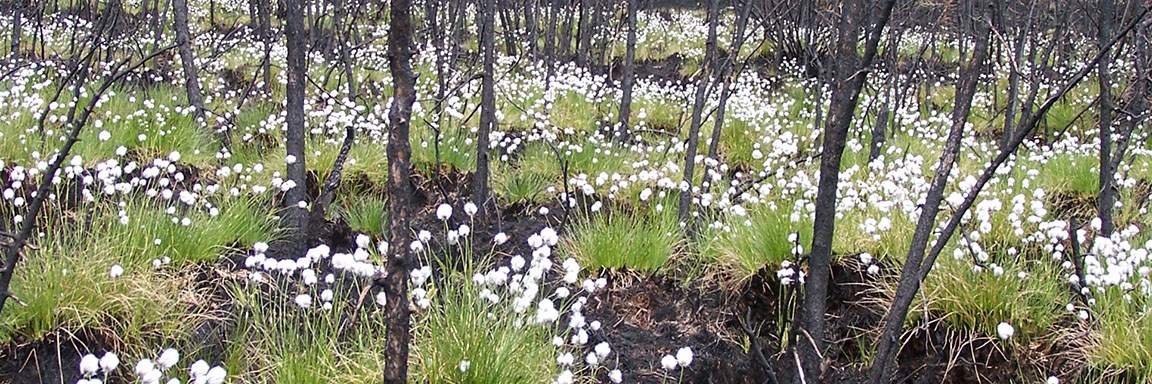
NPS photo
Wildland fire is an essential, natural process in the Alaskan boreal forest and tundra. What at first looks like devastation soon blooms into a panorama of life!
A fire of moderate severity burned in Gates of the Arctic National Park and Preserve. It killed spruce trees but after the fire black spruce cones release an abundance of seeds. Young seedling black spruce trees are likely to establish in the first five years post fire. Cottongrass blooms vibrantly one year after the fire. Shrubs like blueberries, cloudberry, and Labrador tea re-sprout vigorously too. Mosses and lichens were consumed by the fire, but new pioneer species of mosses and liverworts may establish. Over time as the spruce canopy develops, late successional mosses and lichens will re-establish. Birds and wildlife species may take advantage of young nutrient-rich cottongrass and shrubs in recently burned areas. Read on below for more detailed research.
The purpose of the National Park Service, Alaska Fire Ecology Program is to understand the ecological effects of fire on the landscape. Fire ecologists collect and analyze information about the effects of fire on vegetation, fuels, soil, and wildlife habitat and the fire behavior associated with vegetation and fuel types. The results inform fire management planning, objectives, and decisions.
Currant Creek Fire Ecology Tour
In July 2013, lightning ignited the Currant Creek Fire, which grew to nearly 1,900-acres in Lake Clark National Park & Preserve. One year later, a fire ecology crew visited the burned area to determine the fire effects on the vegetation and soils. See what they found through this interactive map tour.
Research
Fire science research informs fire management questions, decisions, and actions. The Alaska National Park Service Fire Management Program has collaborated with universities and interagency partners to study the role of tundra fires in Noatak National Preserve over the past 5,000 years and climate change impacts on fire. Research revealed that fire is a natural process on the tundra. Ecologists have also researched burn severity mapping in Alaska national park units. Burn severity influences vegetation patterns and succession after a fire. Read the Alaska Park Science articles below for more information.
Alaska Park Science, Volume 10, Issue 1
Projected Vegetation and Fire Regime Response to Future Climate Change in National Parks in Interior Alaska
Alaska Park Science, Volume 10, Issue 1
The Burning Tundra: A Look Back at the Last 6,000 Years of Fire in the Noatak National Preserve, Northwestern Alaska
Alaska Park Science, Volume 4, Issue 1
Space-Based Burn Severity Mapping in Alaska's National Parks
What happens after a Tundra Fire (Noatak National Preserve)
Links
Denali National Park and Preserve Fire Ecology
NPS Fire & Aviation Program, Fire Ecology
Policy Guidance, Fire Monitoring Handbook, Data Management, Analysis, and Results, Adaptive Management in Fire Monitoring, Fire Effects Monitoring, Fire Ecology Contacts, Fire Ecology Stories, Research and more.
Alaska Fire Science Consortium
Last updated: December 20, 2018
